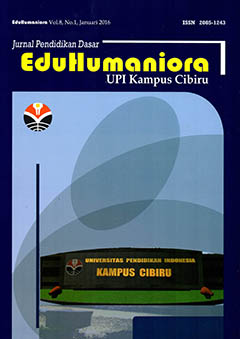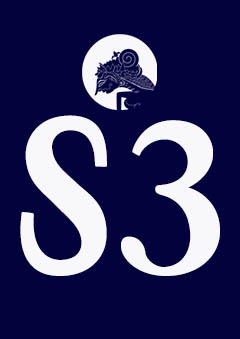PENERAPAN PENDEKATAN PEMBELAJARAN SAINTIFIK PENDIDIKAN JASMANI UNTUK MENINGKATKAN KUALITAS PEMBELAJARAN SISWA SEKOLAH DASAR
Abstract
Abstract: One of the efforts to improve the management of physical education learning through scientific approach which gives ample opportunity for students to critical thinking, analysis and precise in solving problems in teaching physical education. The purpose of this study is to improve student learning elementary school. This research method using Action Research (PTK) collaborative. Data collection techniques using field notes, interview sheets, observation sheets, and a photo camera. Location of the study conducted in SDN Jatihurip Sumedang District of the North with the studied subjects totaling 35 students of class VI student. The results of the study includes planning, teacher performance, student activities, student learning outcomes. In cycle 1, aspects of planning reached 74.16%, aspects of teacher performance reached 68.33%, aspects of student activity reached 42.10% of the overall target of 90% and aspects of learning outcomes that otherwise completed 47.38% of the target of 90%. In the cycle to two aspects of planning reached 88.83%, aspects of teacher performance reached 89.16%, aspects of student activity reached 55, 26% and aspects of learning outcomes expressed 87.57 although not reached the target of 90%. In the 3rd cycle, planning aspect only reached 97.75%, aspects of teacher performance only reached 99.16%, aspects of student activity shows the results of 97.36% and aspects of learning outcomes that otherwise completed reached 94.73% exceeded the target of 90%. The conclusion of this study is the use of physical education scientific approach to learning can be used to improve student learning outcomes.
Keywords: Learning Approach, Sports Education, Learning outcomes
Abstrak: Salah satu upaya memperbaiki pengelolaan pembelajaran pendidikan jasmani melalui pendekatan saintifik yang memberi kesempatan yang luas kepada siswa untuk berfikir secara kritis, analisis dan tepat dalam memecahkan masalah dalam pembelajaran pendidikan jasmani. Tujuan penelitian ini adalah untuk meningkatkan pembelajaran siswa sekolah dasar. Metode penelitian ini menggunakan Penelitian Tindakan Kelas(PTK) kolaboratif. Teknik pengumpulan data menggunakan catatan lapangan, lembar wawancara, lembar pengamatan, dan kamera foto. Lokasi penelitian dilaksanakan di SDN Jatihurip Kecamatan Sumedang Utara dengan subjek yang diteliti siswa kelas VI berjumlah 35 siswa. Hasil penelitian meliputi perencanaan, kinerja guru, aktivitas siswa, hasil belajar siswa. Pada siklus 1, aspek perencanaan mencapai 74,16%, aspek kinerja guru mencapai 68,33%, aspek aktivitas siswa mencapai 42.10% dari keseluruhan target 90% dan aspek hasil belajar yang dinyatakan tuntas 47,38% dari target 90%. Pada siklus ke 2 aspek perencanaan mencapai 88,83%, aspek kinerja guru mencapai 89,16%, aspek aktivitas siswa mencapai 55, 26% dan aspek hasil belajar yang dinyatakan 87.57meskipun belum mencapai target 90%. Pada siklus ke3, aspek perencanaan hanya mencapai 97,75%, aspek kinerja guru hanya mencapai 99,16%, aspek aktivitas siswa menunjukkan hasil 97.36% dan aspek hasil belajar yang dinyatakan tuntas mencapai 94,73% melampai target 90%. Kesimpulan penelitian ini adalah penggunaan pendekatan pembelajaran saintifik pendidikan jasmani dapat digunakan untuk meningkatkan hasil belajar siswa.
Kata Kunci: Pendekatan Pembelajaran, saintifik Penjas, hasil pembelajaran dan kurikulum 2013.
Full Text:
PDFReferences
Barringer, M.D., et al. (2010) Schools for All Kinds of Minds: Boosting Student Success by Embracing Learning Variation. Alexandria: ASCD.
Cresswell, J.W.(2012). Educational Research: Planning, Conductiong, and Evaluating Quantitative and Qualitative Research. New York: Pearson Merril Prentice Hall.
Departemen Pendidikan Nasional. (2013). Standar Kompetensi dan Kompetensi Dasar Tingkat SD/MI. Jakarta: BSNP
Elliot, J. (1993) Action Research for Educational Change. Philadelphia: Open University Press.
Joyce, B. and Weil, M. (l996). Model of Teaching. Englewood Clifs. New Jersey: Prentice HallInc.
Kuhlthau, C. C., Maniotes, L. K., dan Caspari, A. K. (2007) Guided Inquiry: Learning in The 21st Century. London: Libraries Unlimited.
Rubdy, R. (2014) Selection of Materials dalam B. Tomlinson. Developing Materials for Language Teaching.London: Bloomsbury Academic.
Seels, B. B. and Richey, R. C. (1994). Teknologi Pembelajaran: Definisi dan Kawasannya. Washington DC. Association for Educational Communication and Technology.
Someks, B. and Davis, N. (1997). Using Information Technology Efectively in Teaching and Learning, Study In Pre Service and In Service Teacher Educational. London and New York 11. New Fetter Lane in the USA.
Trilling, B. & Fadel, C. (2009) 21st Century Skills: Learning for Life in Our Times. San Francisco: Jossey-Bass A Wiley Imprint.
Vriens, D. (2004). Information and Communication For Competitive Intelegence. University of Nijmegen The Netherland, Idea Grouf Publishing.
Weinbaum, A., et al. (2004)Teaching as Inqury: Asking Hard Questions to Improve Practice and Student Achievement. New York: Teaching College Press.
DOI: https://doi.org/10.17509/eh.v8i1.5121
Refbacks
- There are currently no refbacks.
Copyright (c) 2017 Kampus Cibiru 2016
EduHumaniora: Jurnal Pendidikan Dasar
Published in collaboration Program Studi PGSD UPI Kampus Cibiru
and
HDPGSDI
This work is licensed under a Creative Commons Attribution-ShareAlike 4.0 International License.















